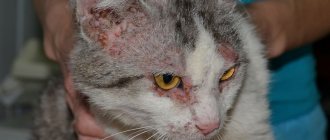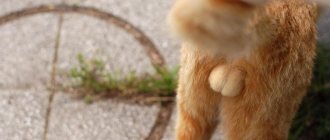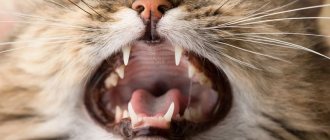8294Administration
For owners of adult cats during their sexual heat, problems such as marking their territory, aggressiveness of the pet, and preventing the appearance of unwanted offspring become relevant.
There are two main ways to solve them:
- temporary suppression of sexual desire with hormonal drugs;
- surgical castration.
Since long-term use of hormones significantly increases the risk of various complications, including cancer, veterinarians advise opting for castration. This procedure, if prepared in advance, is not hazardous to health , does not reduce the hunting instinct and playfulness of the animal, it will no longer develop testicular cancer and the likelihood of developing a prostate tumor will be reduced. Owners who have decided to undergo surgery are faced with the question of how to prepare their cat for castration.
When is the operation performed?
The operation should be performed after the age of 9 months. However, in order not to encounter the typical behavior of a mature male, it is better to carry it out before puberty at 6 months.
Many shelters and nurseries practice early castration at 3 months, since by this age the kittens are already quite independent, they have received all the necessary vaccinations.
Early castration of animals slows down their growth and development, but this does not have global consequences; growth will still continue according to the genetically programmed program. In the case of partial castration with leaving the appendages of the connective tissue base of the testes (vasectomy or sterilization), the hormonal function of the gonads is not disrupted , which contributes to better growth of the animal, but all problems, except for unwanted reproduction, remain.
© shutterstock
The age limit for castration is limited only by the pet’s health condition and the ability of its body to tolerate anesthesia; if a preliminary examination does not reveal any contraindications, then the operation can be carried out after preliminary preparation.
It does not matter for castration of a cat whether he has already mated or not yet.
Treatment for worms
Preventive treatment of pets against parasites, both external and internal, should be carried out every 3 months (at least 2 times a year). At the same time, the fight against external blood-sucking parasites, such as fleas, ticks, etc. may be needed more often when the animal spends a lot of time outside or communicates with other representatives of the animal world.
10 days before the day scheduled for surgery, it is recommended to treat the cat for helminths (if more than 1 month has passed since the last treatment). Veterinarians recommend using drugs such as Kanikquantel, Milbemax, etc.
What is castration
For females, castration is a more complex abdominal operation to remove the gonads than for males. Owners often confuse and replace the concept of castration with the term sterilization in relation to cats, although in veterinary medicine, sterilization of a cat is associated only with the deprivation of the ability to produce offspring by ligating the oviducts, without removing the reproductive organs, however, in this case, if the cat is not prepared for the procedure, there is a high risk of polycystic disease ovaries and inflammation in the uterus.
Correctly, the operation to remove the ovaries and uterus is called ovariohysterectomy; this is the best option for the prevention of all kinds of gynecological diseases.
When it comes to removing only the ovaries, an oophorectomy is performed. It is better for the cat owner to understand these terms in order to speak the same language with the doctor and get the desired result from the operation.
Nutrition and drinking regime
Exactly 12 hours before the manipulation, you need to stop feeding the cat and make sure that the animal does not feed on its own (for example, by pulling a tasty morsel from the table).
If you neglect this rule, vomiting may occur while under anesthesia. This is very dangerous, as the animal can choke on its own vomit.
If the animal is accustomed to drinking water, a bowl with a small amount of water can be left in its usual place. Let the cat drink at night, but on the day of the manipulation, drinking water, like food, is prohibited in the morning.
How to prepare a cat for surgery
Preparing a cat for castration does not contain a large list of activities.
- Firstly, as part of the preparation, it is necessary to carry out vaccination before castration and deworming, wait for the quarantine period, and check the general health of the cat with a veterinarian.
- You cannot feed a cat before castration. To prepare the body, it is necessary to fast a diet for at least 8 hours before surgery and abstain from drinking for 3-4 hours.
- The cat should be washed the day before castration.
General information
There are only two disadvantages to the operation:
- Castration is not reversible.
- If there are errors in diet and due to the characteristics of the breed, the cat may develop urolithiasis over time.
There are many more advantages to castrating a cat:
- The cat stops marking its territory.
- Problematic behavior during the rut becomes a thing of the past, as the rut no longer happens.
- The cat becomes more docile, aggression decreases.
- The risk of prostate cancer is reduced or completely eliminated.
- Castrated cats live 1.5-2 years longer than their uncastrated counterparts.
Carrying out the operation
After preparation, castration is performed through surgery under general anesthesia.
© shutterstock
The cat must be prepared for castration by a veterinarian. He administers anesthesia, removes hair from the animal's scrotum, treats the skin of the testicles with alcohol and then iodine. It’s good if the clinic has a separate anesthesiologist, this indicates a high level of the institution.
Through a small, 1-1.5 cm, incision in the scrotum, the testes are removed . The testes (or testes) are the paired sex glands of cats, in which, upon reaching puberty, sperm and the male sex hormone, testosterone, are formed. The spermatic cords extend from the testicles.
Removal of the testes occurs after the spermatic cord is twisted to prevent bleeding and a ligature of a special material is applied to it. Complete dissolution of the thread occurs spontaneously within three months. The wound is treated with a sterile cloth and a special spray containing antibiotics. The wounds on the scrotum are very small, so stitches may not be required; healing occurs very quickly. Their additional processing from the owner is not required.
Such an operation, including preparation, lasts up to half an hour, 15 minutes for anesthesia and about the same for surgery. The animal can be picked up immediately or left in the hospital to recover from anesthesia (for about three hours).
A common problem in cats is cryptorchidism, which is the failure of the testes (testicles) to descend into the scrotum. It can be one- or two-sided. Both the owner and the doctor must find out before the operation whether this pathology exists.
It is necessary to treat a cryptorchid cat by castration and removal of the testicle from the abdominal cavity or groin. At the same time, the second, healthy testis must be removed. At the same time, it is not permissible to remove a healthy testicle and leave the undescended one. Firstly, this may become a prerequisite for the development of testicular cancer, and secondly, behavioral deficiencies in the cat’s sexual heat will continue to bother the owners.
Usually the cat returns to normal life after surgery within 48 hours , complications are rare, and to minimize and prevent them, preliminary preparation, precision of the doctor’s hands and post-operative care are necessary. In case of a suspicious course of the postoperative period, namely prolonged weakness, drowsiness, lack of appetite, you should immediately contact a veterinary clinic.
© shutterstock
Tests and vaccinations
In order for a cat to be admitted to surgery without any problems, the following medical certificates must be provided:
- the result of a general blood test;
- blood biochemistry results"
- urine test results;
- a certificate from a cardiologist about the state of the cardiovascular system (for “aged” cats and animals suffering from obesity).
Since castration takes place under general anesthesia, anesthesia can provoke an increased load on the heart, therefore, in the presence of any cardiac pathologies, sterilization of males is strictly contraindicated.
The tailed patient, like a person, needs to be tested before surgery
Consequences
The consequences of the operation include complications after emasculation, predisposition to diseases, as well as changes in behavior.
Post-castration complications
During the operation, bleeding may occur, which is eliminated by the surgeon. Primary hemorrhage is less dangerous than secondary hemorrhage, which occurs suddenly, after a few hours, and can cause death from large-scale blood loss. Therefore, the animal owner needs to maintain contact with the operating veterinarian.
Hernias
Most often, the problem arises when castrating an elderly patient using the open method. But even in young cats, due to a congenital anomaly, the inguinal rings may be too wide, the vaginal membrane, the stump of the vas deferens, intestinal loops or omentum fall out. The pathology is corrected surgically.
Wound infection
The infection is caused by a cat scratching or licking the wound surface. For protection, a blanket is put on the body of the operated animal. To prevent the cat from licking itself, an Elizabethan collar is used. The cat litter box is cleaned of feces twice a day.
Predisposition to diseases
For emasculated cats, two metabolic pathologies are characteristic - urolithiasis (urothiasis), as well as obesity and its consequences.
Urolithiasis disease
The disease occurs as a result of drinking poor-quality water, but more often due to poor nutrition. Economy-grade feed, fish, and meat trimmings lead to an excess of nitrogenous components. They are toxic, and the cat’s body eliminates them in the form of sparingly soluble uric acid salts. When precipitated, stones are formed, creating obstacles to the outflow of urine. Mostly males suffer due to the tortuosity of the urethral meatus.
After emasculation, the cat's body continues to grow, but the lumen of the urethra, the development of which is influenced by androgens, remains unchanged. This is the main cause of the disease. You can prevent urotiliasis by using soft, preferably bottled, water, as well as food for castrated animals. You cannot treat your pet to fish, meat or human food.
Very fat cat
Obesity
Depriving a male of his manhood leads to hormonal modification, which negatively affects mobility. Obesity causes diseases such as:
- cardiac and renal failure;
- urothiasis;
- constipation;
- diabetes;
- arthritis;
- malignant neoplasms.
You can get rid of excess weight by limiting the amount of food, as well as by arranging active games. The apartment should have toys - “tall tree”,
"Tall tree"
House for a cat, teasers, game tracks, wind-up mice, etc.
House for a cat
Briefly about the diet for castrati
The most important question that concerns not only owners, but is also of utmost importance in terms of the future health of the pet: how to feed it correctly and what food is best for neutered cats. It is difficult to answer unequivocally, since nutrition should be ideally suited to a particular animal, based on its characteristics.
All that remains is to give a few tips on choosing:
- the inscription “for castrated” does not mean anything, so we study the composition;
- food marked “light” is ideal for animals prone to obesity - they are low in carbohydrates and fats;
- in an ideal food for castrates, protein should be at least 50%, in extreme cases in the range of 30% and above;
- ash content is not higher than 7%, otherwise there is a risk of kidney stones;
- food class is only super-premium or holistic - they do not contain dangerous chemical additives or plant proteins;
- When introducing a new finished product, it is advisable to conduct a digestibility analysis after a month.
Post-operative care
For the first 2–4 days, the wound remains swollen and painful, and must be periodically treated with an antiseptic. On days 5–7, the site of intervention ceases to bother the animal. At this time, it is advisable to stop attempts to lick the defect by putting an Elizabethan collar on the cat. After each cat approaches the tray, it is necessary to clean it of excrement to avoid infection of the wound.
6 hours after the operation, the cat’s appetite awakens. For some time he will eat a little, but often. Regardless of what the cat ate before castration, it is advisable to switch it to premium wet food for the first 2-3 weeks, subsequently replacing it with cheaper dry food. The popular food Purina Pro Plan has a moderate price, which is on average 2.3 times higher than the budget food of the same weight of the Whiskas brand, and Kitiket – 3.7 times.











